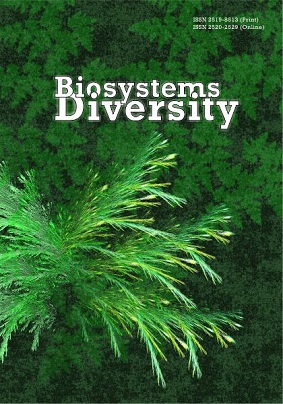Biochemical markers of vital biodestruction in common oak (Quercus robur)
Biochemical markers of vital biodestruction in common oak (Quercus robur)
Author(s): A. F. Likhanov, O. V. Sereda, V. M. Gryb, V. I. Melnyk, L. S. Osadchuk, T. YuskevychSubject(s): Agriculture, Energy and Environmental Studies, Human Ecology, Environmental interactions
Published by: Дніпропетровський національний університет імені Олеся Гончара
Keywords: common oak; rot; xylem; phenolic compounds; markers;
Summary/Abstract: The wood of the common oak (Quercus robur L.) has high mechanical strength, elasticity and resistance to fracture. However, constitutional stability is not always able to provide the plants with reliable protection from wood-decay fungi, and the initial stages of biodegradation are difficult to determine. Therefore, this study concerns research on appropriate biochemical markers for early diagnostics of wood defects. The total content of phenolic compounds in leaves and wood was determined by a spectrophotometer Optizen Pop using Folin & Ciocalteu’s phenol reagent; the flavonoid content in leaves – by adding solutions of aluminum chloride and sodium acetate to methanolic extracts; catechins content – by the reaction with vanillin reagent; the concentration of phenolic antioxidants – by Brand Williams; chlorophyll and carotenoids’ contents in leaves – by the formula for methanol extracts; the qualitative composition of phenolic compounds – by high performance liquid chromatography and highly effective thin-layer chromatography. During the planned felling of oak trees on the territory of the Boyar Forest Research Station, trees were found with signs of brown streak and biodestruction of wood. Brown streak in wood is caused by a polycondensation of phenolic compounds, which are deposited on the internal surfaces of tracheal elements. In cases of an increase in the total amount of oxidized polyphenols, the cell walls are also stained. Active oxidation processes in wood have a systemic nature for the plants and affect the physiological state of the assimilation apparatus. We determined that in leaves of the trees with signs of brown streak the total phenol content increases in comparison with the control by 1.6 times, as well as flavonoid and catechin content. Our research has shown that the complex of plastid pigments in common oak leaves does not significantly change in the early stages of destructive processes. Increase of brown streak and appearance of rot in wood are associated with slight increase in chlorophyll a to b ratio in leaves. Chromatographic profiling of the leaves showed that the presence of brown streak changes the content of individual phenolic compounds. The trees with brown rot have more substances with UV spectrum characteristic for kaempferol glycosides compared to the control. The results have shown that the biochemical profiles of the trees with signs of brown streak and brown rot differ from the control by the composition of low and medium polar compounds. The absence or presence of some individual phenolic components and their ratio in the leaves are considered as biochemical markers of hidden wood defects.
Journal: Biosystems Diversity
- Issue Year: 27/2019
- Issue No: 4
- Page Range: 314-321
- Page Count: 8
- Language: English

